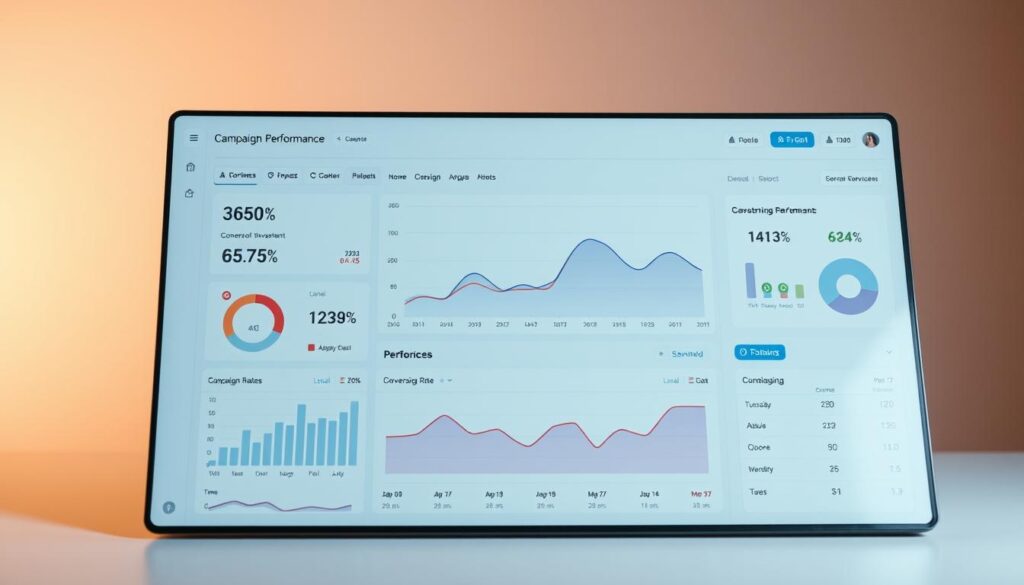AI Marketing Integration for Smarter, Faster Growth
Imagine if the secret to better marketing campaigns was hidden in AI technology. Today, knowing how to use AI in marketing can change the game. It turns old strategies into new, smart ones. With time running short and creativity needed, AI in digital marketing is a big help.
This guide will show you how to add AI to your marketing. It will make your campaigns better and make your work easier.
Understanding AI in Marketing
Artificial intelligence is changing marketing by helping us understand what customers want. It lets businesses look at big data to find patterns. This way, companies can make their marketing better.
AI makes it possible to give customers what they like. Big tech companies have made AI that can make content just for each person. This makes ads more interesting and helps more people buy things.
AI also makes marketing work faster. It can do things like post on social media and send emails for us. This means marketing teams can work on big ideas instead of small tasks. AI can also guess what will work best in future ads, helping teams use their time wisely.
| Benefits of AI in Marketing | Description |
|---|---|
| Increased Efficiency | Automation of manual tasks allows teams to dedicate time to strategy development. |
| Enhanced Personalization | Customized content and experiences cater to individual consumer preferences. |
| Improved Decision-Making | Data-driven insights provide a solid foundation for marketing strategies. |
| Greater Customer Engagement | Targeted marketing leads to higher engagement and retention rates. |
Using AI in marketing makes things better for both users and businesses. With AI, marketers can make ads that really speak to people. This helps build stronger relationships with customers.
Identifying Marketing Goals
Setting clear marketing goals is key for AI marketing success. Marketers need to pinpoint specific objectives. These should focus on improving efficiency, personalization, and boosting revenue. By setting clear goals, companies can see how AI can solve their challenges.
To find these goals, marketers should:
- Look at how marketing is doing now to spot problems.
- Set measurable goals to see if campaigns get better.
- Decide when they want to hit these goals.
For example, a company might want to speed up campaigns by 30% or get better at targeting. Having clear goals helps make sure AI fits into the marketing plan. It helps reach the desired results.
Data Collection and Preparation
Data is key for data-driven marketing. It comes from many places and helps AI work better. Getting the right data makes predictions more accurate and automations smoother.
Marketers need to organize this data well. This makes it easy to use with AI tools.
Starting to use AI in marketing means knowing where your data comes from. This includes:
- Customer surveys and feedback forms
- Website analytics
- Social media interactions
- Email campaign responses
Using the right tools to collect and manage data is important. It helps marketers get insights that improve their strategies. Clean, organized data is essential for AI and marketing success.
Choosing the Right AI Tools
Choosing the right AI tools is key to marketing success. Marketers must pick solutions that meet their specific needs. Tools like predictive analytics forecast trends, while customer bots improve client interactions. Content generation platforms help create engaging materials quickly.
When picking tools, think about how well they fit with your current systems. Tools that are easy to use help marketing teams get started faster. By carefully checking each tool’s features, you can make sure they match your marketing goals.
| Tool Type | Description | Benefits |
|---|---|---|
| Predictive Analytics | Analyzes data to forecast future trends. | Informed decision-making and improved targeting. |
| Customer Engagement Bots | Automates customer interactions. | Enhanced customer service and increased efficiency. |
| Content Generation | Assists in creating marketing materials. | Saves time and enhances creativity. |

Implementing AI in Campaigns
Starting with a detailed campaign brief is key. It sets out the main goals and plans, making sure everyone is on the same page. Using AI in marketing makes campaigns better by combining human skills with tech.
Automation helps with many tasks, like making content, checking it, and setting up when to send it out. This makes online ads more efficient, helping teams work faster and smarter.
Analytics tools let teams see how well campaigns are doing right away. This info helps make quick changes to keep things running smoothly. It’s a mix of creativity and using data well, helping campaigns grow and improve.
Monitoring and Adjusting Strategies
Success in marketing comes from always watching and tweaking strategies. This is key for using AI well in marketing. With automated tools, marketers get quick feedback on how well their campaigns are doing.
Tracking what works helps brands know what to focus on next. This makes marketing with AI more effective. It’s all about finding out what the audience likes and adjusting plans to match.
Setting up feedback loops is important for regular data checks. These loops help make changes based on real results. This way, marketing stays in tune with what people want.
Using predictive analytics is also a big help. It predicts what might happen next, guiding marketing to be more on target. This way, campaigns can be more impactful and relevant.
Keeping up with analysis boosts efficiency and ROI. AI turns data into useful insights for better strategies. This ongoing process keeps marketing fresh and in line with new trends.

Building an AI-Driven Culture
In today’s digital world, it’s key for companies to develop AI skills in marketing. They need to create a culture that values AI. This means educating teams to use AI tools well.
Training staff regularly helps them grasp AI better. This knowledge is vital for using AI tools effectively.
Marketing teams and data experts must work together. This partnership brings new insights and a deeper understanding of AI. It leads to better campaign results and boosts creativity.
Being open to AI is important for change. A culture that welcomes innovation makes team members more confident. They’re more likely to try new things when they feel supported.
This approach improves marketing strategies and boosts AI success. It’s all about embracing change and innovation.
Ethical Considerations in AI Marketing
Artificial intelligence is now a big part of marketing. This means we need to think more about ethical marketing. Companies must handle data privacy, deal with AI biases, and stop AI content misuse. Marketers must act fast to keep things ethical.
Following rules like GDPR is key to ethical marketing. Businesses need to be open about how they use data to keep customers’ trust. They should have strict rules for handling customer data. Keeping data safe not only protects info but also makes the brand look good.
It’s also important to fix biases in AI. Marketing teams should check their AI tools for fairness. Using different data and diverse views can help avoid biases. This makes marketing fairer for everyone.
Setting clear AI use rules helps create a responsible marketing space. Companies that focus on ethics build trust with their audience. This trust leads to strong customer relationships and business growth.
Future Trends in AI and Marketing
The marketing world is changing fast, thanks to AI. Businesses are using new tech to make their marketing better. They’re focusing on making ads that really speak to each person, making customers feel special and loyal.
Also, we’ll see more automated marketing. AI will help pick the best times and places to show ads. This means ads will work better and reach more people. Brands will use these tools to send messages that really matter to each customer, making their work easier and more effective.
Virtual influencers are also on the rise. These AI-powered characters can connect with people in a way that feels real. They’re great for promoting products and services. Marketers need to keep up with these new trends to stay ahead in the digital world.